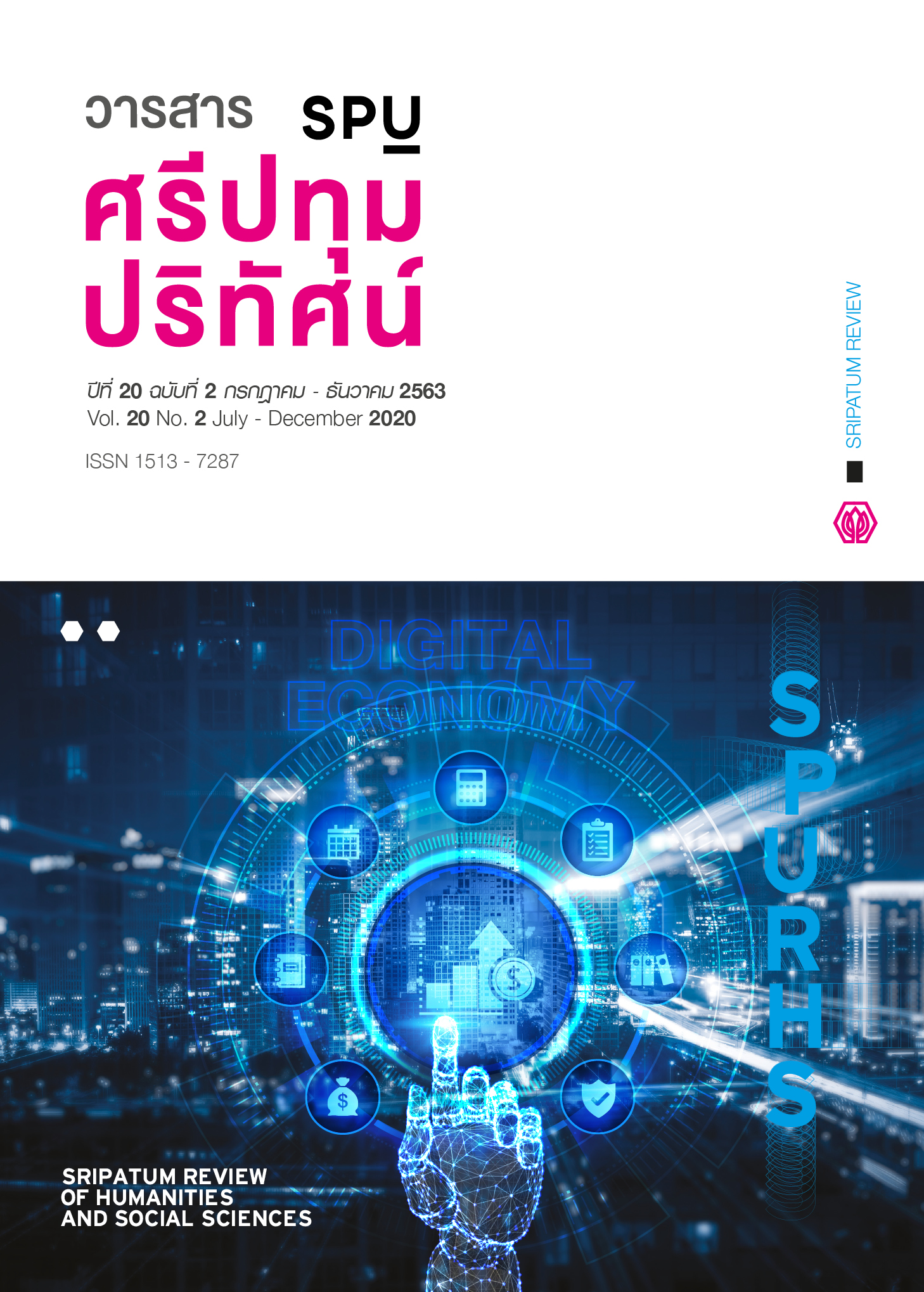Empirical Evidence of Demographic Characteristics Toward Destination Brand Equity of Hua Hin, Thailand
Main Article Content
Abstract
The objectives of this quantitative research were to examine how the variation of demographic characteristics of Thai tourists influences destination brand equity toward Hua Hin destination. The research sample consisted of 400 Thai tourists who had visited Hua Hin destination, obtained by the convenience sampling method. The research instrument was a questionnaire comprising four parts, namely, demographic characteristics, top of mind attraction awareness, brand equity element, and suggestions. Statistics used for data analysis were the percentage, mean, standard deviation, t-test, one-way ANOVA, and Scheffe’s method for pair-wise comparison. The .05 level of statistical significance was pre-determined for hypothesis testing. The results of analyzing the demographic characteristics influencing brand equity factors on tourism destinations indicated that the educational level, residential region and average income per month had an impact on destination brand equity. Therefore, the analysis result confirms that the demographic characteristics of tourists can be the marketing data for creating the marketing strategy and brand strategy to enhance image and reputation for the accurate segmentation, target, and position.
Article Details
1. กองบรรณาธิการสงวนสิทธิ์ในการพิจารณาและตัดสินการตีพิมพ์บทความในวารสาร
2. บทความทุกเรื่องจะได้รับการตรวจสอบทางวิชาการโดยผู้ทรงคุณวุฒิ แต่ข้อความและเนื้อหาในบทความที่ตีพิมพ์เป็นความรับผิดชอบของผู้เขียนแต่เพียงผู้เดียว มิใช่ความคิดเห็นและความรับผิดชอบของมหาวิทยาลัยศรีปทุม
3. การคัดลอกอ้างอิงต้องดำเนินการตามการปฏิบัติในหมู่นักวิชาการโดยทั่วไป และสอดคล้องกับกฎหมายที่เกี่ยวข้อง
References
Aaker, J. L. (1997). Dimensions of Brand Personality. Journal of Marketing Research, 34(3), 347-356. doi:10.2307/3151897
Agarwal, R., Katiyapol, T., and Pienchob, N. (2019). Positive and Negative Impacts of Tourism on Environment: A Case Study of Pattaya City, Thailand. Sripatum Review of Humanities and Social Sciences, 19(1), 139-146.
Allan, M. (2004). Why brand places? [Online]. Retrieved November 11, 2018, from http://beyond-branding.com/Agenda_MSA_Article_Feb2004.pdf
Beerli, A., and Martin, J. D. (2004). Tourists’ characteristics and the perceived image of tourist destinations: A quantitative analysis - a case study of Lanzarote. Tourism Management, 25(5), 623–636.
Butler, R. W. (2006). The Tourism Area Life Cycle: Applications and Modifications (Vol. 1). Clevedon, UK: Channel View Publications.
Chiangchai, N. (2015). The Identity Using to Promote Tourism in Lampang Province. Bangkok: Silpakorn University.
Cochran, W. G. (1977). Sampling Techniques. New York: John Wiley and Sons.
Department of Provincial Administration. (2017). Information Center for Provincial Administration and Development. [Online]. Retrieved May 26, 2017, from http://www2.amphoe.com/menu.php
Engel, J. (2006). Consumer behavior. Mason: OH: Thomson Higher Education.
Hua Hin Municipality. (2017). Three Years Development Plan (2017-2019). Hua Hin: Hua Hin Municipality Development Plan Commitee.
Hua Hin Today Newspaper. (2017). Hua Hin History, Thailand. [Online]. Retrieved February 22, 2017, from: https://www.huahintoday.com/information/e/huahin_info_general/hua_hin_ history.php
Keller, K. L. (2013). Strategic Brand Management: Building, Measuring and Managing Brand Equity. Global Edition: Pearson.
Ministry of Tourism and Sport, Thailand. (2018). Department of Tourism, Ministry of Tourism and Sports, Thailand. [Online]. Retrieved August 23, 2018, from https://www.mots.go.th/ old/more_news.php?cid=531&filename=index
Pike, S., and Bianchi, C. (2016). Destination brand equity for Australia: testing a model of CBBE in short haul and long haul markets. Journal of Hospitality and Tourism Research, 40(1), 14-134. doi:https://doi.org/10.1177/1096348013491604
Prommahaa, J. (2015). Destination Branding: Brand Management and Brand Engagement of Health and Wellness Tourism in Thailand and the ASEAN Region. Sociology Study, 5(8), 653-675. doi:10.17265/2159‐5526/2015.08.006
Saisud, R. (2019). An Empirical Study of Demographic Characteristics Toward Hua Hin Destination Brand Equity, Thailand. The Proceedings of the 14th National and International Sripatum University Conference (SPUCON2019): Research and Innovations for Thailand 4.0 on December 19, 2019 at Sripatum University, 169-178.
Serirat, S. (2007). Consumer Behaivor. Bangkok: Pattanasuksa Publisher.
United Nations Environment Programme. (1997). Guidelines for carrying capacity assessment for tourism in Mediterranean coastal areas. Split, Croatia: Priority Action Programme, Regional Activity Centre.
World Tourism Organization. (2005). Making Tourism More Sustainable - A Guide for Policy Makers. Paris, France: United Nations Environment Programme.
Woyo, E., Slabbert, E., and Saayman, M. (2019). Do socio-demographic characteristics influence destination attractiveness perceptions after political turmoil: the case of Zimbabwe? African Journal of Hospitality, Tourism and Leisure, 8, 1-20. [Online] Retrieved from: https://www.ajhtl.com/uploads/7/1/6/3/7163688/article_55_vol_8_3__2019.pdf


